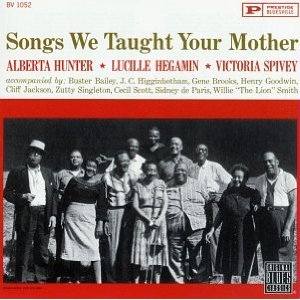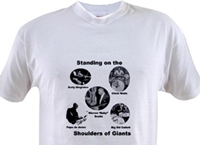The blues musicians I most admire are the ones who fanned out from Kansas City: Basie, Bird, Pres, Jay McShann and countless others. The blues vocalists, though, gave me my introduction at an early age when my late brother and I discovered Bessie Smith in the early 1960s.
As time went on I discovered others, but the one whose story and music truly touched me was Alberta Hunter. The discovery came in 1980 when my brother told me about Amtrak Blues.

This album grabbed my attention. I loved her singing and was blown away to find out that she was 83 years young when she recorded it in 1978. I would have guessed she was in her 30s had I not known better.
Her backing ensemble consisted of Gerald Cook on piano (and who would back her for the remainder of her days), Aaron Bell on bass, Jackie Williams on drums, Billy Butler on guitar, Frank Wess on tenor sax and flute, Noris Turney on tenor sax and clarinet, and two greats - trombonist Vic Dickinson and trumpter "Doc" Cheatham. Cheatham, in particular, lent authenticity to the session by reaching back and playing with the same feel he had used when he backed Bessie Smith decades earlier.
Here are a few tracks from the album:
The album is authentic to be sure, but also swings harder than many jazz albums, and exudes energy. The rhythm section is superb and Jackie Williams' drumming is well worth isolating and studying.
If discovering Amtrak Blues proved to be an auspicious moment in my musical development, discovering an even earlier album, Songs We Taught Your Mother, opened my eyes and ears to some of Bessie's contemporaries, as well as the likes of Zutty Singleton, a drummer who was part of Louis Armstrong's Hot Fives & Sevens sessions between 1925 and 1929 that changed the course of jazz.

Alberta shares this album with two of her contempories: Lucille Hegamin and Victoria Spivey. The styles could not be more different among them, but it was also like a time capsule listening to blues as it was played back in their heydays. A lot of credit goes as much to the backing musicians as to the vocalists. Whoever produced this album understood the importance of authenticity because in addition to Zutty Singleton the ensemble reads like a who's who of pioneers: Cecil Scott on clarinet, tenor saxophone, Buster Bailey on clarinet, Sidney DeParis on trumpet and tuba, Henry Goodwin on trumpet, J.C. Higginbotham on trombone, Cliff Jackson and Willie "The Lion" Smith on piano, and Gene Brooks in the drum chair on some of the tracks along with Zutty.
A few things should jump out at you. First, some of the all time greats like Buster Bailey, J.C. Higginbotham, and Willie "The Lion" Smith are in the ensemble. Second, there is no double bassist. The original ensembles during Alberta's early years employed a tuba instead and this group has that configuration.
Sound samples for the album can be found on this page. While the albums hooked me, I became a staunch fan when I learned Alberta's whole story. I am a sucker for rags-to-riches and improbable success stories. Hers was both and is beautifully documented in My Castle's Rockin'.

This 57 minute video beautifully documents Alberta's life from her birth in 1895 until her passing in 1984. Dr. Billy Taylor is the narrator, but there are others who contribute, including John Hammond. I am not going to provide a synopsis of her story here because it would take up a lot more space that I want to use, but this biography amply covers it. I will say that the documentary is thorough and switches back and forth between her story and a performance at Barney Josephson's The Cookery in Greenwich Village. Here is a clip that will give an idea of the video:
Remember when I started this post with the revelation that Bessie Smith hooked me on blues? One of Bessie's most famous songs was written by Alberta:
Her power and energy is underscored in this 1982 performance at the Smithsonian when she was 87: Jazz Masters Series

Check these clips from that performance out:
Did you note in the clips from My Castle's Rockin' and Jazz Masters Series there was no drummer? Indeed, with her talent and a pianist and bassist she was singing blues that filled the house. Drummers take heed. And guitarists too.
Her body of work, and especially what I have listed in this post, deserves close study by anyone who is serious about being a blues musician. You do not, however, need to be a musician of any kind to enjoy her music or be inspired by her story.
This post is dedicated to my good friend Donna Sweeney - The Daytona Blues Woman - a true blues musician with whom I have shared a stage on occasion, and for whom I have the utmost respect for her talent as a blues musician and her passion for keeping the music alive. She is one of the very few "blues" musicians who actually understands the blues. It is also dedicated to the memory of my late, younger brother - R Kent Tarrani, born on October 16, 1950 and passed away on March 23, 1991 - who introduced me to Bessie, Alberta and a plethora of other blues and jazz pioneers.



No comments:
Post a Comment